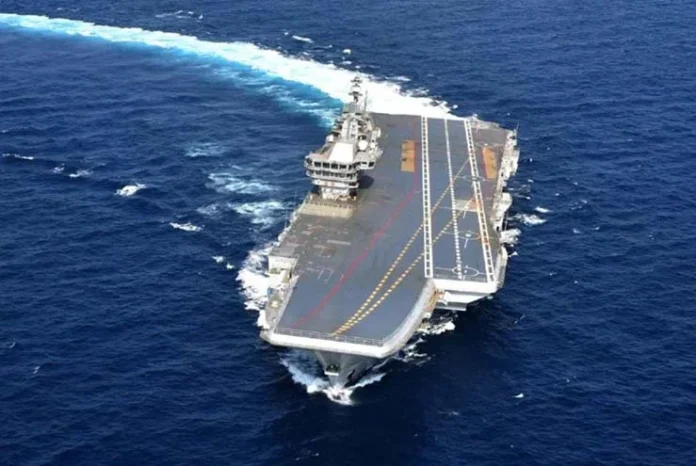New Delhi: The Indian Navy’s proposal for acquiring a second Vikrant-like aircraft carrier displacing 45,000 tonnes was discussed last week by the Defence Procurement Board (DPB). It is estimated to cost of around Rs 40,000 crore. The discussion is expected to continue in the next meeting. The proposal will be put for final approval by the Defence Acquisition Council (DAC) headed by the Defence Minister only after the DPB clearance, according to a media report.
The project will see some modifications and upgrades to the design of the country’s first Indigenous Aircraft Carrier (IAC) INS Vikrant, commissioned in September 2022, and will also be manufactured by Cochin Shipyard Limited (CSL), the media report stated.
INS Vikrant displacing 44,800 tonnes is powered by four General Electric LM2500 engines which give it a maximum speed of 28 knots and an endurance of 7,500 nautical miles. The ship uses an aircraft-operation mode known as Short Take Off But Arrested Recovery (STOBAR) for which it is equipped with a ski-jump for launching aircraft, and a set of three ‘arrester wires’ for their recovery onboard.
In addition, the Navy also operates the 44,500-tonne carrier INS Vikramaditya, which also employs the STOBAR mechanism, procured from Russia under a $2.3-billion deal and inducted in November 2013.
During the Aero India air show in Bengaluru in February, Navy Chief Adm. R. Hari Kumar had said on the sidelines that the Navy is finalising plans to repeat-order a Vikrant-sized carrier, Indigenous Aircraft Carrier-2 (IAC-2), with some modifications. Given the long timelines, it may be inducted “close to the time INS Vikramaditya leaves service effectively becoming its replacement”, he said while adding that the Navy would continue to study the need for a larger and more capable carrier.
The Navy had envisaged an IAC-2 with a displacement of 65,000 tonnes and a Catapult Assisted Take Off But Arrested Recovery (CATOBAR) system for launching aircraft as well as full-electric propulsion. However, a much bigger carrier with newer technologies would mean much higher cost and build time due to which the Navy has settled for a repeat of a Vikrant-sized carrier. The keel of Vikrant was laid in 2009, launched into water in 2013 and commissioned in 2022. With the experience gained, a repeat order can be executed in seven to eight years, according to CSL officials.
For long the Navy has based its force structure centred around three carriers, The Parliamentary Standing Committee on Defence had noted that three aircraft carriers is an “unavoidable requirement” to meet any eventualities. It stated that taking into account the long coastline and hostile adversities on both sides of Indian peninsula, an aircraft carrier on both sides of coast is “quintessential” to uphold operational requirements.




